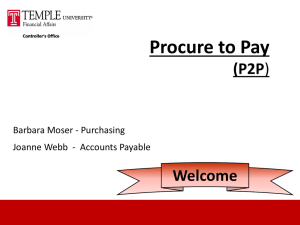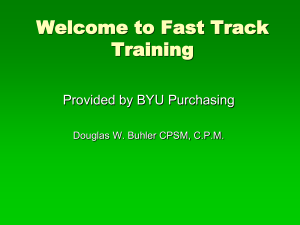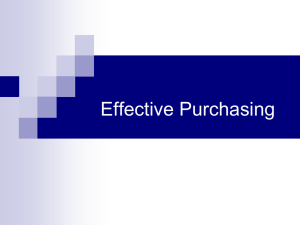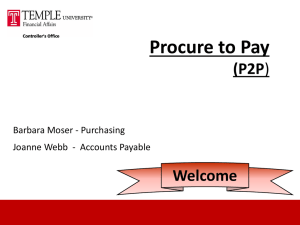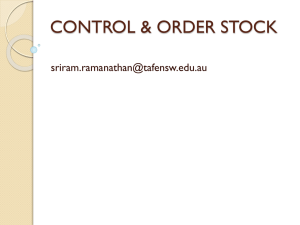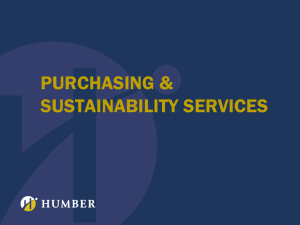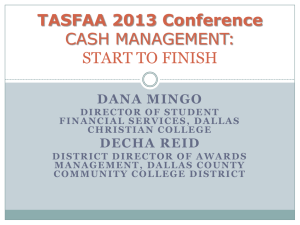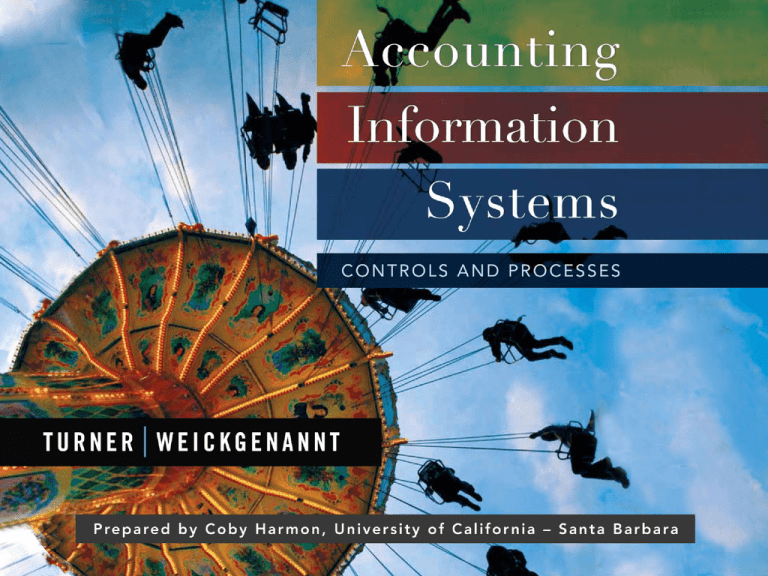
Chapter
9-1
Expenditures
Processes and
ControlsPurchases
Chapter
9-2
Accounting Information Systems, 1st Edition
Study Objectives
1.
An introduction to expenditures processes
2.
Purchasing processes and the related risks and controls
3.
Purchase return processes and the related risks and controls
4.
Cash disbursement processes and the related risks and controls
5.
An overview of IT systems of expenditure and cash disbursement
processes that enhance the efficiency of expenditures processes
6.
Computer-based matching of purchasing documents and the related risks
and controls
7.
Evaluated receipt settlement systems and the related risks and controls
8.
E-business and electronic data interchange (EDI) systems and the related
risks and controls
9.
E-payables systems
10.
Procurement cards
11.
Ethical issues related to expenditures processes
12.
Corporate governance in expenditures processes
Chapter
9-3
Introduction to Expenditure Processes
When a purchase occurs, the information resulting
from that purchase must flow into
the purchase recording systems,
the accounts payable and cash disbursement
systems, and
the inventory tracking systems.
Transaction Processing Systems (TPS)
Chapter
9-4
SO 1 An introduction to expenditure processes
Introduction to
Expenditure Processes
Exhibit 9-1
Expenditures Processes within
the Overall System
Chapter
9-5
SO 1 An introduction to expenditure processes
Introduction to Expenditure Processes
Exhibit 9-2
Comparison of the Revenue and
Expenditures Processes
Chapter
9-6
SO 1 An introduction to expenditure processes
Introduction to Expenditure Processes
Common expenditures processes include:
Prepare a purchase requisition and/or purchase order.
Notify vendor (supplier) of goods or services needed.
Receive goods or services.
Record the payable.
Pay the resulting invoice.
Update the records affected, such as accounts
payable, cash, inventory, and expenses.
Chapter
9-7
SO 1 An introduction to expenditure processes
Purchasing Processes
Terminology
Chapter
9-8
Purchase Requisition
Packing Slip
Purchase Order
Receiving Report
Purchases Journal
Receiving Log
Blind Purchase Order
Cutoff
Bill of Lading
Accounts Payable
Subsidiary Ledger
SO 2 Purchasing processes and the related risks and controls
Purchasing Processes
Exhibit 9-2
Purchasing Process Map
See next slide for larger image.
Chapter
9-9
SO 2 Purchasing processes and the related risks and controls
Purchasing Processes
Exhibit 9-2
Purchasing Process Map
Chapter
9-10
SO 2 Purchasing processes and the related risks and controls
Purchasing Processes
Exhibit 9-2
Purchasing Process Map
Chapter
9-11
SO 2 Purchasing processes and the related risks and controls
Controls and Risks in Purchasing Processes
Common procedures associated with the revenue
process:
Authorization of transactions
Segregation of duties
Adequate records and documents
Security of assets and documents
Independent checks and reconciliation
Cost-benefit considerations
Chapter
9-12
SO 2 Purchasing processes and the related risks and controls
Controls and Risks in Purchasing Processes
Characteristics indicating risk with purchasing processes:
1.
Goods received difficult to differentiate, count, or
inspect.
2. High volumes of goods are received, or goods are of high
value.
3. Inventory pricing arrangements are complex or based on
estimates.
4. Frequent changes occur in purchase prices or vendors.
5. Company depends on one or few key vendors.
6. Receiving and/or record keeping are performed at
multiple locations.
Chapter
9-13
SO 2 Purchasing processes and the related risks and controls
Controls and Risks in Purchasing Processes
Quick Review
Within the purchasing processes, which of the
following is the first document prepared and thereby
the one that triggers the remaining purchasing
processes?
a. The invoice
b. The receiving report
c. The purchase order
d. The purchase requisition
Chapter
9-14
SO 2 Purchasing processes and the related risks and controls
Controls and Risks in Purchasing Processes
Quick Review
Personnel who work in the receiving area should
complete all of the following processes except
a. counting the goods received.
b. inspecting goods received for damage.
c. preparing a receiving report.
d. preparing an invoice.
Chapter
9-15
SO 2 Purchasing processes and the related risks and controls
Controls and Risks in Purchasing Processes
Quick Review
Which of the given departments will immediately
adjust the vendor account for each purchase
transaction so that the company will know the correct
amount owed to the vendor?
a. Purchasing
b. Receiving
c. Accounts payable
d. Shipping
Chapter
9-16
SO 2 Purchasing processes and the related risks and controls
Purchase Returns Processes
Reasons for Returns:
1. Goods received are unacceptable:
Quantity or quality discrepancies
Damage or defects
Errors in the type of goods delivered or ordered
Discrepancies in the terms of the purchase
Timing issues
2. Changes in the company’s needs.
Chapter
9-17
SO 3 Purchase return processes and the related risks and controls
Purchase Returns Processes
Exhibit 9-9
Purchase Returns Process Map
See next slide for larger image.
Chapter
9-18
SO 3 Purchase return processes and the related risks and controls
Purchase Returns Processes
Exhibit 9-9
Purchase Returns Process Map
Chapter
9-19
SO 3 Purchase return processes and the related risks and controls
Purchase Returns Processes
Exhibit 9-9
Purchase Returns Process Map
Chapter
9-20
SO 3 Purchase return processes and the related risks and controls
Risks and Controls in the Purchase Returns
Process
Specific controls over the purchase returns
process:
Authorization of transactions
Segregation of duties
Adequate records and documents
Security of assets and documents
Independent checks and reconciliation
Cost-benefit considerations
Chapter
9-21
SO 3 Purchase return processes and the related risks and controls
Risks and Controls in the Purchase Returns
Process
Quick Review
The document prepared when purchased items are
returned is a(n)
a. debit memo.
b. invoice.
c. receiving report.
d. sales journal.
Chapter
9-22
SO 3 Purchase return processes and the related risks and controls
Cash Disbursement Processes
Cash disbursements process must be designed to ensure
that the company appropriately processes payments to
satisfy its accounts payable when they are due.
Terminology:
Cash management
Remittance advice
Cash disbursements journal
Chapter
9-23
SO 4 Cash disbursement processes and the related risks and controls
Cash Disbursement Processes
Exhibit 9-14
Cash Disbursement
Process Map
See next slide for larger image.
Chapter
9-24
SO 4 Cash disbursement processes and the related risks and controls
Cash Disbursement Processes
Chapter
9-25
Exhibit 9-14
Cash Disbursement
Process Map
SO 4 Cash disbursement processes and the related risks and controls
Cash Disbursement Processes
Chapter
9-26
Exhibit 9-14
Cash Disbursement
Process Map
SO 4 Cash disbursement processes and the related risks and controls
Risks and Controls Cash Disbursement
Process
Specific controls over the cash receipts process:
Authorization of transactions
Segregation of duties
Adequate records and documents
Security of assets and documents
Independent checks and reconciliation
Cost-benefit considerations
Chapter
9-27
SO 4 Cash disbursement processes and the related risks and controls
Risks and Controls Cash Disbursement
Process
Quick Review
Which of the following controls is not normally performed
in the accounts payable department?
a. The vendor’s invoice is matched with the related
receiving report.
b. Vendor invoices are selected for payment.
c. Asset and expense accounts to be recorded are
assigned.
d. Unused purchase orders and receiving reports are
accounted for.
Chapter
9-28
SO 4 Cash disbursement processes and the related risks and controls
Risks and Controls Cash Disbursement
Process
Quick Review
In a system of proper internal controls, the same
employee should not be allowed to
a. sign checks and cancel the supporting voucher
package.
b. receive goods and prepare the related receiving
report.
c. prepare voucher packages and sign checks.
d. initiate purchase requisitions and inspect goods
received.
Chapter
9-29
SO 4 Cash disbursement processes and the related risks and controls
Risks and Controls Cash Disbursement
Process
Quick Review
Within accounts payable, to ensure that each voucher is
submitted and paid only once, each invoice approved to be
paid should be
a. supported by a receiving report.
b. stamped “paid” by the check signer.
c. prenumbered and accounted for.
d. approved for authorized purchases.
Chapter
9-30
SO 4 Cash disbursement processes and the related risks and controls
IT Systems of Expenditure and Cash
Disbursement Processes
Three-Way Match - matching of a purchase order
to the related receiving report and invoice.
Time consuming and expensive.
Business Process Reengineering (BPR) to improve
efficiency and effectiveness. IT systems include:
Chapter
9-31
Computer-based matching and checking of
purchasing documents
Evaluated receipt settlement (ERS)
Electronic forms of purchase and payment
SO 5 An overview of IT systems of expenditure and cash disbursement
processes that enhance the efficiency of expenditures processes
IT Systems of Expenditure and Cash
Disbursement Processes
Exhibit 9-19
Document Matching to
Approve and Pay for
Purchases
Exhibit 8-17 is a
system flowchart
of a generic
version of revenue
system with
some paper
documents.
Chapter
9-32
SO 5 An overview of IT systems of expenditure and cash disbursement
processes that enhance the efficiency of expenditures processes
Computer-Based Matching
Automated matching - software matches an invoice to its
related purchase order and receiving report.
Advantages
Chapter
9-33
Risks
reduce time,
system errors
costs,
unauthorized access,
errors, and
fraud, and
duplicate payments
in invoice processing.
inadequate backup of
files.
SO 6 Computer-based matching of purchasing documents
and the related risks and controls
Risks and Controls in Computer-Based
Matching
Security and Confidentiality Risks
Processing Integrity Risks
Availability Risks
Chapter
9-34
SO 6 Computer-based matching of purchasing documents
and the related risks and controls
Elevated Receipt Settlement
Prior to 2000, some companies, began implementing
invoice-less matching systems for purchasing and
paying vendors.
Evaluated receipt settlement (ERS) - receipt of
goods is carefully evaluated and, if it matches the
purchase order, settlement of the obligation occurs
through this system.
Chapter
9-35
SO 7 Evaluated receipt settlement systems
and the related risks and controls
Risks and Controls in Elevated Receipt
Settlement
Security and Confidentiality Risks
Processing Integrity Risks
Availability Risks
Chapter
9-36
SO 7 Evaluated receipt settlement systems
and the related risks and controls
Risks and Controls in Elevated Receipt
Settlement
Quick Review
Which of the following IT systems is designed to avoid
the document matching process and is an “invoiceless”
system?
a. Computer-based matching system
b. Electronic data interchange
c. Evaluated receipt settlement
d. Microsoft Dynamics GP®
Chapter
9-37
SO 7 Evaluated receipt settlement systems
and the related risks and controls
E-Business and Electronic Data Interchange
Value
Added
Networks
(VANs)
Exhibit 8-18
EDI Using a ThirdParty Network
Chapter
9-38
Risks and Controls in El-Business and EDI
Exhibit 9-20
E-Business and EDI
Risks and Controls
Chapter
9-39
SO 8 E-business and electronic data interchange (EDI)
systems and the related risks and controls
Risks and Controls in El-Business and EDI
Quick Review
Input controls such as field check, validity check, limit
check, and reasonableness check are useful in IT systems
of purchasing processes to lessen which of the following
risks?
a. Unauthorized access
b. Invalid data entered by vendors
c. Repudiation of purchase transactions
d. Virus and worm attacks
Chapter
9-40
SO 8 E-business and electronic data interchange (EDI)
systems and the related risks and controls
E-Payables
Electronic Invoice Presentment and
Payment (EIPP)
Takes advantage of the connectivity of the Internet
to electronically send invoices or payments.
Chapter
9-41
SO 9 E-payables system
Procurement Cards
Procurement cards
Called p-cards
Credit cards that organization gives to certain
employees to make designated purchases.
Normally not used to purchase raw materials or
products
Used for small-dollar-amount purchases.
Chapter
9-42
SO 10 Procurement cards
Ethical Issues Related to Expenditures
It is important to establish internal control policies
and IT controls to help prevent or detect such
fraud, ethical lapses, or errors.
Chapter
9-43
SO 11 Ethical issues related to expenditures processes
Ethical Issues Related to Expenditures
It is important to establish internal control policies
and IT controls to help prevent or detect
fraud,
ethical lapses, or
errors.
Chapter
9-44
SO 11 Ethical issues related to expenditures processes
Ethical Issues Related to Expenditures
Quick Review
Which of the following is most likely to be effective in
deterring fraud by upper level managers?
a. Internal controls
b. An enforced code of ethics
c. Matching documents prior to payment
d. Segregating custody of inventory from inventory
record keeping
Chapter
9-45
SO 11 Ethical issues related to expenditures processes
Corporate Governance in Expenditure
Processes
Corporate governance policies should incorporate the
four areas of
management oversight,
internal controls,
financial stewardship, and
ethical behavior.
Chapter
9-46
SO 12 Corporate governance in expenditure processes
Copyright
Copyright © 2008 John Wiley & Sons, Inc. All rights reserved.
Reproduction or translation of this work beyond that permitted
in Section 117 of the 1976 United States Copyright Act without
the express written permission of the copyright owner is
unlawful. Request for further information should be addressed
to the Permissions Department, John Wiley & Sons, Inc. The
purchaser may make back-up copies for his/her own use only
and not for distribution or resale. The Publisher assumes no
responsibility for errors, omissions, or damages, caused by the
use of these programs or from the use of the information
contained herein.
Chapter
9-47


